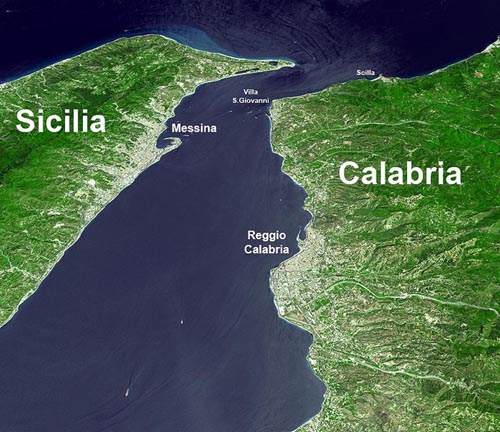Fretum Siculum
Strait of Messina
The Strait of Messina is, at its narrowest point, just 2 miles wide. A number of classical writers refer to a time when Sicily was still connected to Italy. In fact legend has it that Heracles was responsible for their separation. However, Cyprian Broodbank has pointed out in his monumental work, The Making of the Middle Sea, that “Today, the Messina strait dividing it (Sicily) from peninsular Italy is a minimum of 3 km (2 miles) wide and 72 metres (235 ft) in depth at its shallowest point. On the face of it, therefore, Sicily and mainland Italy should have fused under full glacial conditions. Yet this spot lies on a plate boundary and has already risen several metres over the last 150 years for which accurate measurements exist. Add a 127,000-71,000-year-old beach now elevated 90m (300ft) above the sea near the strait and we might start to wonder whether Sicily was ever solidly attached to the other land.”[1127.91] Nevertheless, he does suggest that early man possibly had stepping-stones in the form of islets and shallows between the two landmasses.
The Strait of Messina had a reputation in antiquity for having dangerous currents, which are thought to be the inspiration for Homer‘s sea monsters, Scylla and Charybdis. Heinrich Schliemann supported this identification[1243]. The currents there are still very dangerous, but nevertheless the strait is a busy waterway with both commercial and pleasure craft, indicating that the conditions there can be mastered. The hazards were situated at the northern end of the Strait, where today there is a town appropriately called Scilla on the Calabrian side.
The strait is sometimes offered as an earlier site for the Pillars of Heracles prior to the Western Mediterranean becoming more frequently navigated by the ancient Greeks, at which time the term was transferred to the Strait of Gibraltar. Winfried Huf is a keen supporter of ‘Pillars’ having been located at Messina. A constituent part of the Western Mediterranean was the Tyrrhenian Sea, which, for the Greeks, would have been most easily accessed through the Strait of Messina.
The earliest westward expansion of the Greeks was understandably to what became known as Magna Graecia in Sicily and southern Italy. The Phoenician expansion was along the north African coast eventually establishing Carthage at the Strait of Sicily. The ships available at that time were not designed for the open sea, but were usually kept within sight of land. I am inclined to think that the early Greeks would have had the Strait of Messina as the location of their Pillars of Heracles leading to the little known Western Mediterranean (or Tyrrhenian Sea), apparently referred to by some as the ‘Atlantic Sea’, whereas the Strait of Sicily might have led to conflict with the Phoenicians!
It is interesting that from around 330 BC and for nearly a thousand years(b) the Strait of Messina was known as Fretum Siculum, which translates as the Sicilian Strait. Philo of Alexandria (20 BC-50 AD) in his On the Eternity of the World(c) wrote “Are you ignorant of the celebrated account which is given of that most sacred Sicilian strait, which in old times joined Sicily to the continent of Italy?” (v.139).
>Alexander V. Podossinov in his paper on straits and their significance for the ancients commented “the Carthaginians for a long time did not permit the Greeks to pass through the Straits of Messina and had power over the whole western Mediterranean.”(d)<
Support for the idea of the Western Mediterranean being the ‘Sea of Atlantis’ with the ‘Pillars’ at the Strait of Messina is presented on a French forum(a), which offers the map below.
(a) https://histoiresecrete.leforum.eu/t716-quelques-questions-se-poser-sur-le-Tim-e-Critias.htm
(b) https://pleiades.stoa.org/places/462494


